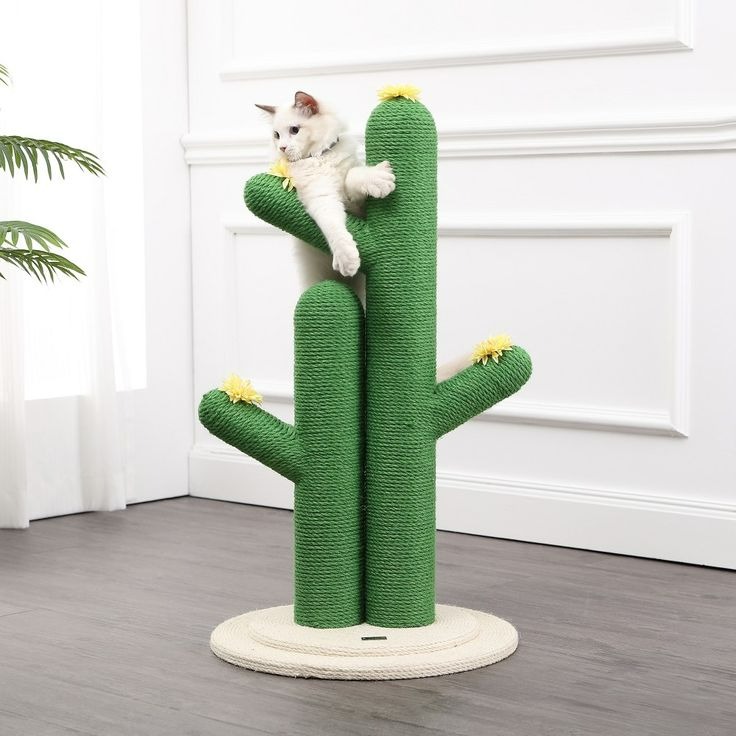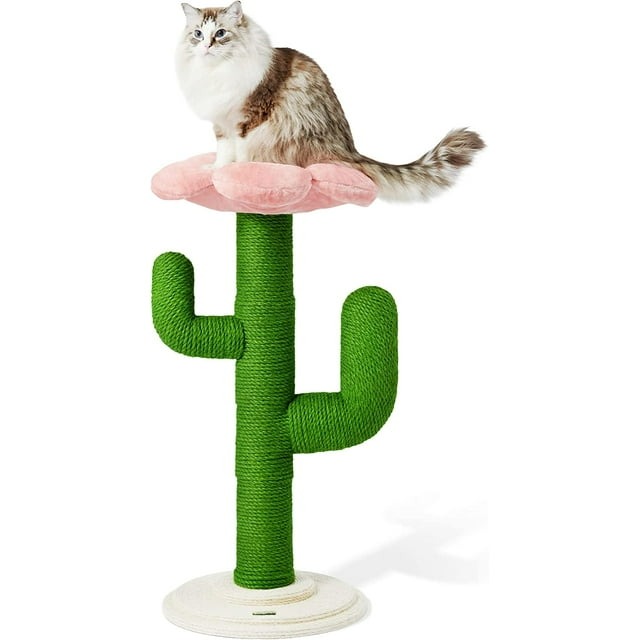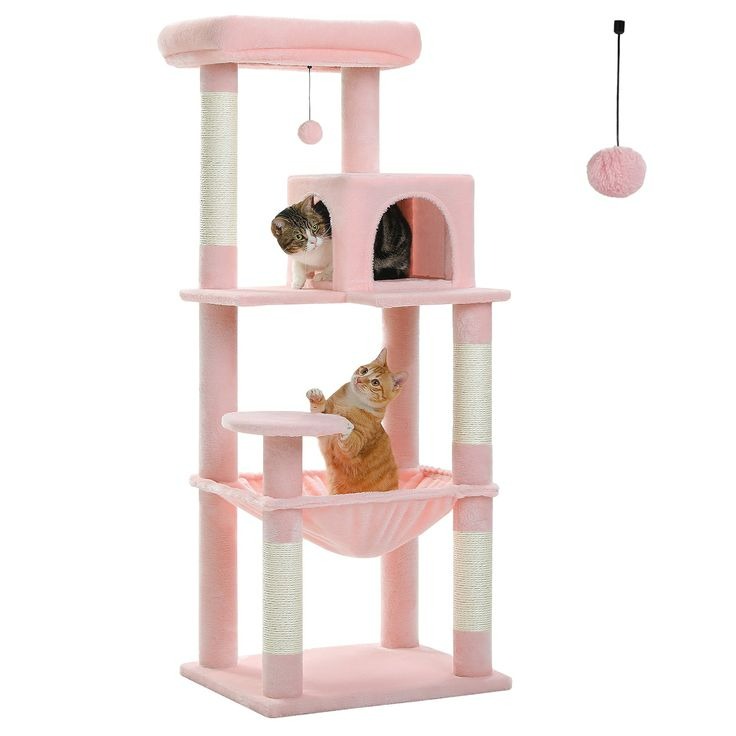Introduction to Cactus Cat Trees
Cat owners know that felines adore climbing and scratching. A cactus cat tree is a fun, unique solution for your kitty’s needs. It blends design, fun, and function in one. Cat trees come in various shapes. The cactus shape is a quirky and stylish option. It often includes multiple perches and scratch posts. Like real cacti, these trees can be a bold decor statement.
The concept of a cactus cat tree is simple. It mimics the natural environment of a desert cactus. This makes it both playful for the cat and eye-catching for owners. Cats love to scratch, and the posts of a cactus cat tree provide the perfect texture. They can climb to the top perch, similar to climbing a real tree. This satisfies their climbing instinct. The cactus shape also adds fun to their play. Owners love how it looks in their home. It creates a conversation piece that is also cat-friendly.
Infusing the cactus theme into a cat tree requires creativity. It calls for the right mix of materials and design. This ensures it is safe and enjoyable for cats. In the following sections, we will dive into the essential features. We’ll explore what makes a cactus cat tree both functional and stylish. We’ll also look at materials, DIY tips, and maintenance. With the right cactus cat tree, your cat can enjoy hours of fun. And you can enhance your home’s aesthetic.

Essential Features of a Cactus Cat Tree
A cactus cat tree must cater to feline instincts and owner preferences. When designing one, consider the following features:
- Sturdy Base: The foundation guarantees safety. Make sure it is wide and heavy. This prevents the cat tree from tipping over.
- Scratch-Ready Surfaces: Cats need to scratch. Use materials that mimic the rough texture of a cactus. Sisal fabric works well.
- Multiple Levels: Cats enjoy vertical space. Add perches at varying heights. This allows for climbing and resting.
- Comfortable Perches: Cats love to lounge. Ensure perches are padded and spacious.
- Play Features: Incorporate toys or hanging items. These stimulate play and exercise.
- Durable Construction: Select materials that withstand sharp claws and lots of activity.
Remember, the cactus cat tree should be inviting for the cat and appealing for the owner. It’s essential to balance functionality with style for this unique piece of cat furniture.
Choosing the Right Materials
When creating a cactus cat tree, selecting the proper materials is crucial for both safety and durability. Let’s explore the ideal components that make up this fun and functional piece of furniture:
- Sisal Fabric: This is a top choice for the scratching surfaces. It resembles a cactus’s texture and resists wear and tear from claws.
- Wooden Frames: Use sturdy wood to shape the structure. It ensures stability and long-term use.
- Soft Padding: Cats seek comfort for lounging. Add plush padding on perches for ultimate relaxation.
- Non-Toxic Paint: If coloring the tree, choose paints that pose no health risks to cats if ingested.
- Quality Fasteners: Secure all parts with strong screws or bolts. This keeps the tree firm and safe while in use.
These materials combine to provide a safe, robust, and comforting cactus cat tree that stands the test of time and use.

Style and Design Considerations
When planning your cactus cat tree, style and design are as important as function. Here are some key points to think about:
- Color Matching: Choose colors that fit with your room’s scheme. This way, your cactus cat tree looks as good as it is fun for your cat.
- Cactus Look: Aim for a design that resembles a real cactus. Think about how many arms your cactus will have and how it will stand out in your home.
- Innovative Textures: Add different textures to keep your cat interested. Mix rough with soft areas for varied sensations.
- Custom Touches: Consider adding areas where you can hang toys or insert catnip. It makes the cactus cat tree more enticing.
- Size and Space: Measure your available space. Make sure the cat tree is not too big or too small for the room it will be in.
- Visual Appeal: Design with an artistic touch. Remember, this cat tree will be a part of your home decor.
- Theme Consistency: If you have a particular home theme, ensure your cat tree complements it. A cactus cat tree can fit well with a boho or desert-themed interior.
A well-designed cactus cat tree should be a haven for your feline friend and a stylish addition to your home. With careful planning, you can achieve both and ensure your cat has a beautiful and functional piece to enjoy.
DIY vs. Purchasing: Pros and Cons
Creating a cactus cat tree yourself or buying one has both upsides and downsides. Let’s weigh these as you decide what’s best for your cat and home.
DIY Pros:
- Customization: You control the design. Make it fit your space and your cat’s preferences.
- Cost Savings: DIY can be cheaper. You pick materials and avoid labor costs.
- Satisfaction: Building it yourself adds personal value. It’s rewarding to see your cat enjoy your creation.
DIY Cons:
- Time Consuming: It takes time to plan and build. You need patience and free time.
- Skill Level: You must have some craft skills. Without them, it could be tough to make.
- Tool Access: You need the right tools. If you don’t have them, it could add cost.
Purchasing Pros:
- Convenience: Buy it and it’s ready. No work needed on your part.
- Expert Craftsmanship: Store-bought models are professionally made. They often last longer.
- Guarantees: Purchased trees may come with warranties or guarantees you don’t get with DIY.
Purchasing Cons:
- Higher Cost: You pay for materials, labor, and brand. This can add up.
- Less Personal: It’s not custom made. It might not match your home as well as a DIY.
- Variety Limitations: You might not find the perfect one. Stores have limited styles and designs.
Consider your skill level, budget, and what will make your cat happiest. This will guide whether you DIY or buy your cactus cat tree.

Popular Cactus Cat Tree Models on the Market
When exploring the models available, certain cactus cat trees stand out. Here’s a look at popular ones:
- The Classic Cactus: This model mimics a traditional cactus with green tones and has several levels.
- The Deluxe Desert Oasis: It’s a larger option, featuring soft beds and multiple scratching posts.
- The Mini Saguaro: Perfect for small spaces, this one offers the basics in a compact design.
- The Boho Chic Cactus: This features stylish patterns and a unique look for modern homes.
- The Multi-Cat Mirage: With extra perches and spaces, it’s ideal for households with several cats.
Each model offers a mix of the essential features needed for a cat’s enjoyment and owner satisfaction. Remember to pick one that fits your space and complements your home’s style. Selecting from these top models ensures your pet gets quality fun and you get a durable piece of furniture.
Safety Tips for Cat Trees
Ensuring your cactus cat tree is safe is vital for your cat’s well-being. Here are some safety precautions to consider:
- Stable Base: Confirm the base of the cat tree is solid. It should not wobble.
- Check Materials: Be sure all materials are non-toxic and safe for cats.
- Regular Inspection: Look for loose parts or wear and tear. Fix issues promptly.
- Appropriate Height: Avoid overly tall trees if your cat is old or clumsy.
- Secure Anchoring: If possible, anchor the tree to a wall for extra stability.
- Avoid Sharp Edges: All edges should be smooth to prevent injury.
- Position Wisely: Place the cat tree away from high-risk areas like windows or stoves.
By following these tips, you’ll create a safer environment for your feline to play and relax on their cactus cat tree.
Maintenance and Care for Longevity
To keep your cactus cat tree in tip-top shape, regular maintenance and care are key. Here’s how to ensure longevity and the continued joy of your feline companion:
- Routine Inspection: Check for any loose components or signs of wear. This helps prevent accidents and ensures durability.
- Clean Regularly: Dust and clean the cactus cat tree frequently. A clean tree is more inviting for your cat and better for its health.
- Tighten Fasteners: Over time, screws and bolts may loosen. Tighten them periodically to keep the cat tree stable.
- Replace Worn Parts: If a part of the tree is worn out, like the sisal fabric, replace it promptly. It keeps the tree safe and appealing.
- Keep it Dry: Moisture can damage the tree and lead to mold. Keep it away from water sources and clean up any spills immediately.
- Avoid Chemicals: When cleaning, use non-toxic cleaners. Cats are sensitive to chemicals, and safety comes first.
- Monitor Stability: Make sure the tree doesn’t tip or wobble. If it does, it may need repositioning or additional anchoring.
By following these simple steps, your cactus cat tree will remain a cherished spot for your cat and a stylish piece in your home for years to come.


